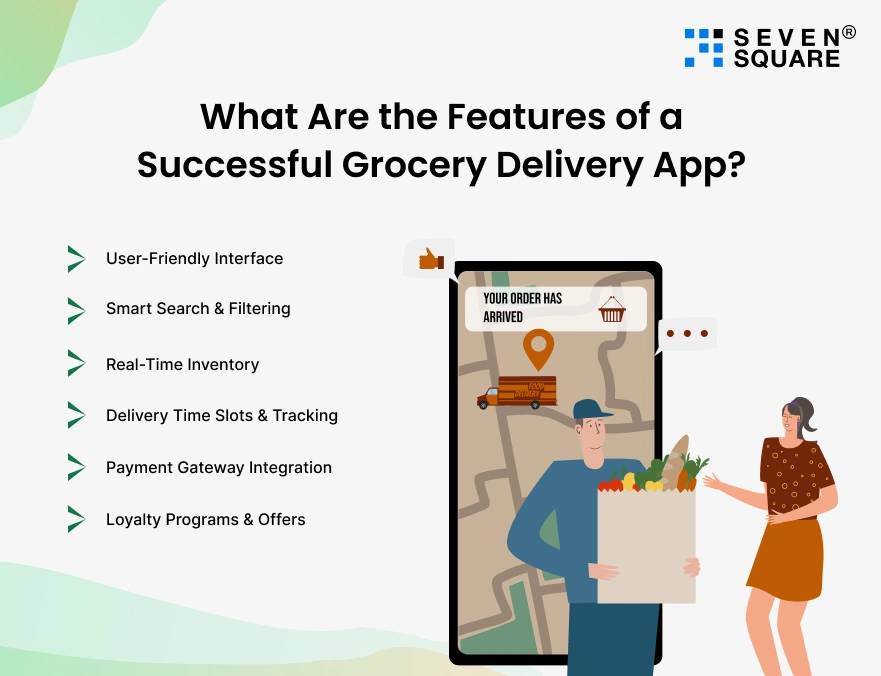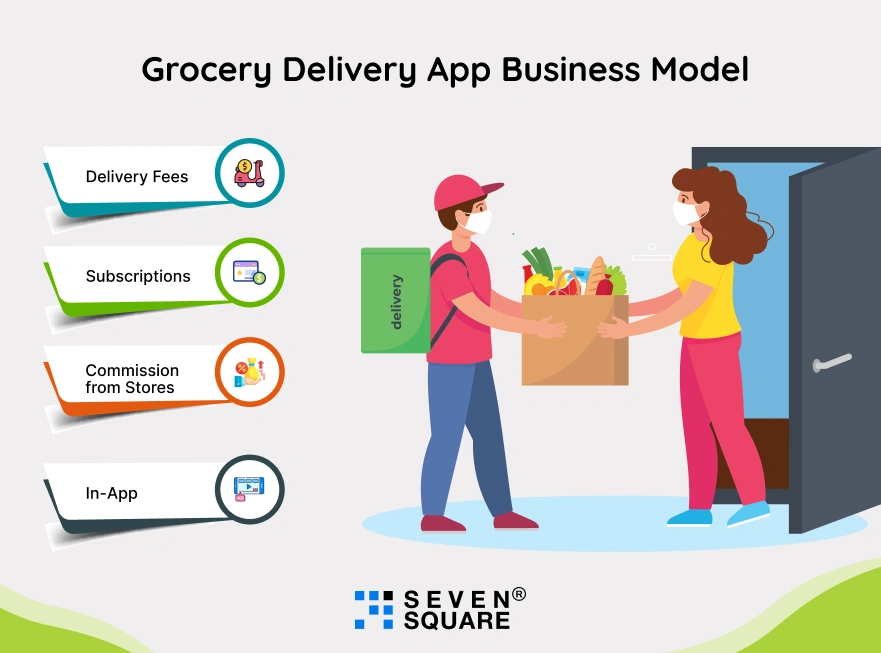Imagine this: It’s a rainy Thursday evening.
You’ve had back-to-back meetings, your fridge is nearly empty, and your usual grocery delivery app crashes just as you’re adding milk to the cart.
Frustrating? Sure. But more importantly, it’s an opportunity.
Or maybe you’re on the other side of the equation: a founder or product manager who’s tired of watching inefficient, buggy, or overly generic grocery delivery apps dominate a space they barely understand.
You’re convinced you can build something smarter with faster checkout, better delivery routing, real-time stock updates, and features that work.
You’re not just dreaming about a grocery delivery app, you’re ready to build one that wins in 2025.
We’ve helped launch custom grocery delivery apps and on-demand platforms for companies across industries, from local grocers to national retailers.
This guide is built on that experience.
Whether you’re exploring how to build a grocery delivery app from scratch, want to know what it costs, or are comparing successful grocery delivery app examples, we’ve packed it all in here.
Why Grocery Delivery Apps Still Have Room to Win in 2025?
The market isn’t just hot, it’s evolving.
In 2025, the best grocery delivery app isn’t just fast; it’s intuitive, localized, and personalized.
People don’t want to scroll through 50 items, they want their usuals, fresh and on time.
That’s why founders are rethinking how to build a grocery delivery app that’s not just functional but truly profitable and scalable.
Real-World Use Case
We worked with a regional grocery chain last year that wanted to compete with the likes of Instacart.
In just five months, we built a grocery delivery app customized according to their local supply chain and customer behavior.
Not a clone but a custom solution with real retention power. That’s what happens when you combine engineering with product thinking.
What Are the Features of a Successful Grocery Delivery App?

These are non-negotiable if you want to compete:
- User-Friendly Interface: Quick load times, clean UI, and intuitive navigation, because if your app makes people think, they bounce.
- Smart Search & Filtering: Let customers find what they need fast. That means voice search, barcode scanning, and predictive suggestions.
- Real-Time Inventory: Avoid one of the biggest turn-offs: ordering something only to find it’s out of stock. Sync with store databases.
- Delivery Time Slots & Tracking: Give users control over when and how their groceries arrive. Real-time tracking isn’t a luxury; it’s expected.
- Payment Gateway Integration: Support multiple payment methods, including BNPL options like Afterpay or Klarna. The more flexible, the better.
- Loyalty Programs & Offers: Retention matters. Reward your frequent users with discounts, points, or personalized bundles.
Grocery Delivery App Development Cost in 2025
Here’s what you’re asking: “How much will it cost to build a grocery delivery app like Instacart?”
Projected Costs:
- MVP: $3,000 to $6,000
- Full-featured app: $7,000 to $12,000+
Costs vary depending on complexity, integrations, and whether you’re building for iOS, Android, or both.
At Seven Square, we’ve delivered apps under tight budgets and timelines by cutting fluff and focusing on what drives revenue.
Grocery Delivery App Tech Stack
Choosing the right stack early on saves time, money, and rework later.
- Frontend: React Native or Flutter for cross-platform speed
- Backend: Node.js with Express or Python with Django
- Database: PostgreSQL, MongoDB, or Firebase
- Cloud: AWS or Google Cloud for scalability
- Other Tools: Firebase for push notifications, Stripe or Razorpay for payment, Twilio for SMS updates
We’ve used all of these to build fast, reliable grocery delivery apps across industries.
Grocery Delivery App Business Model

Monetization isn’t an afterthought. Here’s how successful apps make money:
- Delivery Fees: Charge a flat or distance-based delivery fee.
- Subscriptions: Offer a monthly plan with perks like free delivery and early access to discounts.
- Commission from Stores: Partner with stores and take a cut from every order.
- In-App Ads: Feature sponsored products or priority listings from vendors.
Our team has helped clients choose and implement the right grocery delivery app monetization strategy based on their market and growth goals.
How to Build a Grocery Delivery App: Step-by-Step?
Whether you’re a startup or an enterprise, the process stays consistent. Here’s a deeper look at what each step involves:
1. Research & Validation
- Before writing a single line of code, talk to users.
- What are their pain points with current grocery delivery apps?
- Study competitors, especially local ones.
- Read their reviews, understand gaps in service, and identify unmet needs.
- This step ensures you’re building something useful, not just another app.
2. Define Scope & Budget
- Decide if you’re building an MVP or a fully-featured product from day one.
- Your budget will influence the feature set, technology choices, and timeline.
- At this stage, you should also define your KPIs, whether it’s user retention, order frequency, or delivery turnaround time.
3. Design Wireframes & UX Flows
- This is the blueprint phase.
- Good design isn’t just how it looks, it’s how it works. Keep the journey from search to checkout frictionless.
- Think through every screen: product pages, cart management, address selection, payment, and order tracking.
- Our designers at Seven Square ensure every click counts.
4. Choose Tech Stack
- Now bring in your developers and architects. A grocery delivery app needs a strong foundation.
- Choosing the right tech stack ensures your app can scale, stay secure, and integrate with third-party services like payment gateways and logistics APIs.
- Revisit our tech stack section above for a proven setup.
5. Develop Core Features
- Time to code. Start with the essentials:
- User registration and profile management
- Product listing and search
- Cart and checkout
- Delivery scheduling and live tracking
- Admin dashboard for store management.
- This phase is handled in agile sprints, so you can test and iterate fast.
6. Integrate Payments & Notifications
- Use secure, globally trusted providers like Stripe, Razorpay, or PayPal for payments.
- For real-time user communication, set up email, SMS, and in-app notifications. Tools like Twilio and Firebase make this seamless.
7. Test, Fix, Repeat
- QA is where you catch bugs, test edge cases, and ensure performance under load.
- Test across different devices, networks, and user scenarios. Simulate real-world situations, like delayed deliveries or payment failures.
8. Launch & Iterate
- Once you’re confident in your MVP, go live, but keep listening.
- Collect feedback, track usage analytics, and iterate quickly. The first launch is just the beginning.
- Many of our clients at Seven Square continue to evolve their apps based on customer feedback and market changes.
How Seven Square Builds Grocery Delivery Apps That Scale?
We’re a team of experienced developers who build with one goal: working software that grows your business.
Here’s how we deliver:
- Swift delivery: We move fast. Your MVP won’t take forever.
- Clear communication: Weekly check-ins, clear timelines, no surprises.
- Uncompromising quality: We ship only what we’d use ourselves.
We’ve built everything from MVPs to full-fledged multi-store grocery delivery apps. With every project, we bring speed, product intuition, and relentless focus on value.
Want a grocery delivery app? Contact Us Now!
Real-World Grocery Delivery App Examples
Here’s what the best looks like:
- BigBasket: Huge in India, known for localized inventory and flexible delivery.
- FreshDirect: Strong in urban areas, focused on fresh produce.
- Shipt: Known for excellent customer service and fast delivery.
What can you learn from these grocery delivery app examples? They’re not trying to do everything. Each app has a clear value proposition.
FAQs
- The cost to build a grocery delivery app in 2025 starts from $7,000 to $12,000+, depending on your feature set, design complexity, and tech stack.
- A basic MVP may cost less, while a full-featured, scalable solution with real-time tracking, multi-store support, and secure payments will cost more.
- If you want full control over features, performance, and scalability, custom development is the better choice.
- White-label apps are faster to launch but often lack flexibility and long-term differentiation in a competitive market.
- Yes. A well-built grocery delivery app can integrate with your existing POS, ERP, or inventory management systems via APIs.
- This allows real-time syncing of product availability, pricing, and stock updates.
- Yes, many successful apps start with a hyperlocal launch.
- Focusing on one region allows you to test, iterate, and optimize before scaling to other areas.
- It’s also easier to build relationships with local suppliers and logistics partners.